|
By accessing or using The Crittenden Automotive Library™/CarsAndRacingStuff.com, you signify your agreement with the Terms of Use on our Legal Information page. Our Privacy Policy is also available there. |

A Day at the Races - A perspective on car racing
|
|---|
|
|
A Day at the Races - A perspective on car racing
Matt Hubbard
Speedmonkey
October 21, 2012
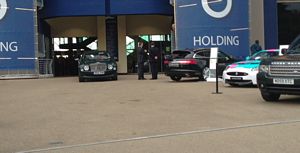 The Queen's Bentley - alongside the new Jaguar Sportsbrake The Queen's Bentley - alongside the new Jaguar Sportsbrake
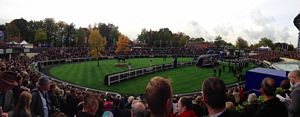 The winners enclosure. This is outside the track The winners enclosure. This is outside the track
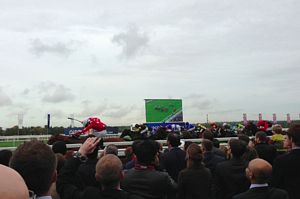 You can get this close to the action. Only Monaco or Isle of Man TT come close You can get this close to the action. Only Monaco or Isle of Man TT come close
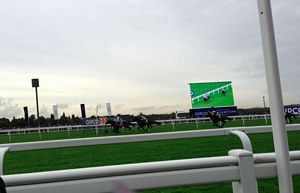 Final race, final win, final furlong. Frankel leads towards the line Final race, final win, final furlong. Frankel leads towards the line
 The grandstand. 35,000 people were in attendance The grandstand. 35,000 people were in attendance
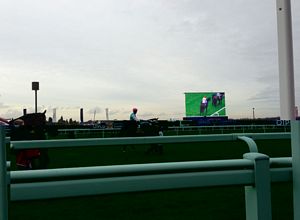 Frankel walking to the start line Frankel walking to the start line
|
Yesterday I spent the day at a horse race with my family. Hopefully you won't immediately stop reading and feel as if you've been lured here under false pretences - this is a motoring website after all.
I felt there was a lot in common with the car racing world and it would be worthwhile drawing parallels to see how car racing could improve as a spectacle as a result of looking at horse racing.
The event we went to was one of the highlights of the calendar. Champions Day at Ascot. The big race was the QIPCO Champion Stakes and featured only six horses and riders. However it may go down in history as one of the most famous horse races ever to have taken place.
The star attraction was a horse called Frankel. He was entered in his first ever race at age 2 (a racehorses lifespan is about 25 years) and is still only 4 years old. He has run 14 races and has won every single one. He may go down as the best race horse of all time and yesterday he ran (and won) his final race.
Frankel will now be retired. He will become a stud horse, and mares (4 year old female horses) will be brought to him to be inseminated. A service for which Frankel's owners will charge £100,000 a time.
Poor Frankel will be expected to service 120 mares a year. In two years time the first of his offspring will start their first race and then his value as a stud will go up or down depending on how they perform.
This is all on top of career earnings of £3million.
As a Champion of Champions he can be regarded in the same light as Senna, Loeb, Prost, Stewart, Clark, Fangio - however none of them won every single race they entered.
Anyway, enough about Frankel. As this was my first ever horse race what struck me was how similar horse racing is to motor racing. Each features thoroughbred race 'machines' that need to be kept in garages or stalls before the race. Each has a paddock area where the competitors are displayed and checked over before the race, each goes to the purpose built track with straights and corners. Each has a defined start and finish line and the finish line is close to a grandstand where the paying spectators can cheer on the winner. The list goes on.
Many motor racing terms derive from horse racing (whose history goes back a few thousand years further than auto racing). The paddock, the grandstand, the track, the thoroughbreds.
Indeed the term pole position has its origins in horse racing, in which the fastest qualifying horse would be placed on the inside part of the course, next to the pole.
Parallels can also be drawn between the make-up of the competitors in horse and auto racing. Frankel is a champion due to a number of different factors. Other horses have many of these but none has them in such quantities as Frankel.
A race horse has an unusually large heart. In order to run at top speed over the distance he or she will pump blood round his or her body at a vast rate. Other organs such as lungs and spleen will also be larger on a regular winner than in an also-ran.
So the physical make up of a horse can make it run faster and for longer. Just as the Williams FW14B dominated the 1992 Formula 1 season due to being a superior machine, even though it weighed as much as the other cars in the field and was subject to the same regulations.
A horses mind is an important tool in it's winning armoury. Horses, like humans, come with differing levels of intelligence and competitive spirit. Some are happy to run midfield, despite being pushed to win by the jockey, and some relish the competition and run at the front. Some will hear the roar of the crowd and use it to urge them on whilst others get spooked by all the paraphernalia and noise surrounding them and misbehave or pull up short.
Some will push too hard to soon, tire and fall back at the line. Frankel's secret weapon is that he can run midfield and then will himself along during the last half of the race - making the others seem slow in comparison. This is something we saw Michael Schumacher do with monotonous regularity during his winning period of the early 2000s. Yet Rubens Barrichello, with the same machinery, was unable to do anything more than act as his reargunner.
A winner such as Schumacher or Frankel makes it look easy whilst the rest of the field try their very best and struggle to understand why they cannot beat the champion.
The jockey is not a mere passenger. He will talk to, encourage, hold back when required, urge along when necessary and generally control the beast. A thoroughbred horse will not win without a jockey who can use it as a tool with which to win races. The role of the jockey is similar in part to the driver and in part to the race engineer of an F1 driver. Rob Smedley's encouraging messages to Felipe Massa are an excellent example of this.
A horse racing paddock has a similar feel to that of a car racing paddock. Although by necessity a car racing track is much longer and therefore the track is spaced over a larger area.
The thought occurred to me, as I rushed from trackside position to the winners enclosure, that horse racing is a more inclusive sport.
Immediately after the race the horses and riders are brought to a circular enclosure, with banked steps surrounding it, where everyone can rush to and watch the competitors, dripping with sweat and exhausted from their exertions, receive their trophies. HRH Queen Elizabeth II presented the prizes at Ascot and 5,000 of us watched on.
I felt that, with the exception of Formula 1, car racing paddocks fail to capture this exhilaration - this thrill, this continuation of the excitement we had all felt. The wonderment that these thoroughbred chargers brought to us all.
And that is my final point. Race goers have a stake in the horse race. Most have put a small bet on a horse or two. Five or ten pounds. This gives an extra dimension of inclusion into the outcome of the race. When Frankel was approaching the final furlongs the cheers from the crowd was as nothing I've heard before. Sure, the crowd knew they were witnessing a historical event but they all had a financial, and emotional stake in the outcome.
Even during the lesser races the cheer of the crowd, the emotion, the prickling sensation on the back of the neck was testament to a wider need for your horse to win. "Come on," they all cheered as 'their' horse was approaching the line. For they all had a few quid riding on a horse.
Aside from massive race events, with big personalities and high stakes this feeling, this emotion, this electrically charged atmosphere is missing from auto racing crowds.
What can be done to improve the show at car racing events? To improve crowd numbers? I don't know. I don't have the answers. I don't run a race track or host a racing event. But I feel that people such as Jonathan Palmer could do worse than visiting a few horse races to see what they do that we (car and bike racing aficionados) can do.

















